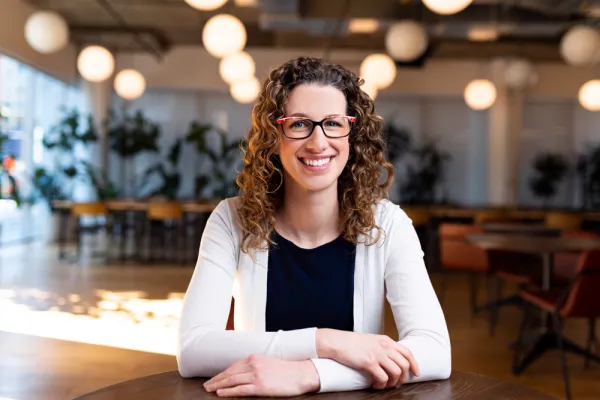Power of the Sun
Alum News

Published March 25, 2020
The idea of community solar sounds as popular as a blue sky. Sun power for everyone.
Yet, most Americans can’t access solar energy directly.
But Emily Robichaux ’05 has an innovative approach to community solar—one that puts cash in people’s pockets, thus better enabling them to afford the energy they need to power their households. “It’s a way of going solar without actually needing anything on your own roof, or even needing a roof at all,” she says.
Robichaux is director of project finance and product development at Groundswell, a nonprofit in Washington, D.C., that develops community solar projects for low- and moderate-income households in D.C., Maryland and Georgia. She coordinates with investors and financial partners to finance community solar projects, and she works with Groundswell’s customers to design products and services that are “rooted in transparency and respect.”
Groundswell’s aim is to put solar energy to work for people who can’t put solar panels on their roofs. That might be because they’re renters, or they simply can’t afford it. Groundswell develops solar-power arrays—more than 13 megawatts—and provides subscriptions to these projects to residents in the areas they serve. Market-rate customers pay a rate for their subscriptions similar to what they pay the utility for “brown” power, and the customers allocate the 5 percent to 10 percent savings made possible by solar to local low-income households also subscribed to the project—saving these households in need as much as $500 per year on their utility bills.
For example, one Groundswell solar project—a 151-kilowatt-capacity ground-mounted system at a monastery in Washington, D.C.—generates utility bill savings for 50 households in the area. Thirty-eight market-rate households pay to subscribe and receive the savings, and 12 low-income households receive the savings at no cost to them.
“What has motivated me is knowing that there is a very direct, concrete impact on people’s lives,” Robichaux says.
Community solar—meaning a solar power plant whose electricity is shared by more than one property—has emerged because, despite an increased appetite for clean energy, 50 percent to 75 percent of U.S. consumers cannot access traditional rooftop solar. They may not own their roofs or their roofs may not be suitable for solar collection, according to a 2018 report by the energy research firm Wood Mackenzie.
Robichaux grew up amid smoky oil refineries in south Louisiana. She remembers the refineries being “very accepted, but they never really seemed to fit in with the way that I thought we would be wanting to live in the world.” Before beginning her full-time role at Groundswell, Robichaux held a Clean Energy Leadership Institute fellowship with the organization. She was also a Net Impact food fellow, providing resiliency consulting services to the D.C. Central Kitchen, and she was a member of the winning team of the 2017 Columbia University Energy Symposium Case Competition.
“I started to realize that my passion was to work at the intersection of sustainability and social justice,” she says. The roots to that passion took hold at Smith. Robichaux was an “Earth rep” for her house, mainly focused on recycling. But “at that time, I couldn’t really put words to what my passion would be; it took a while to discover it.”
At Smith, she says, “I became more comfortable with my own voice and understanding that I had a role, and that I needed to take on that role and not just sit back and let others do it.”
Could community solar make sense for you?
Community solar has a presence in 42 states and the District of Columbia, including 23 states where programs are run voluntarily by utilities, according to Emily Robichaux. She offers tips on ways to participate in community solar:
Buy a portion of the solar array. This usually involves an upfront payment. This option is most similar to owning an array on your own home. Ownership agreements may vary, but you are likely entitled to the energy produced by your portion as well as other incentives associated with the project, such as the federal investment tax credit, and state incentives like the solar renewable energy credit.
Sign a power purchase agreement. You agree to purchase a certain amount of the production for an extended period of time at a specific per-kilowatt-hour rate, probably below your current rate.
Subscribe to the solar project. You pay a monthly fee to the operator of the array in order to be eligible for electricity bill credits. Your subscription may be for a fixed amount of kilowatts and entitles you to the power produced from that portion of the project.
Freelance writer Tom Kertscher is a 35-year newspaper reporter, most recently for the Milwaukee Journal Sentinel.
This story appears in the Spring 2020 issue of the Smith Alumnae Quarterly.
SMITH ALUMNAE QUARTERLY
Special Climate Issue

Mission: HEALTHY EARTH
How the Smith community is fighting to save our planet
SMITH ID
EMILY ROBICHAUX ’05
DIRECTOR of project finance and product development, Groundswell
SMITH MAJORS: French studies, government
FURTHER EDUCATION: M.B.A. in sustainability, Bard College, 2018
Photograph by Jimell Greene